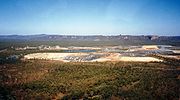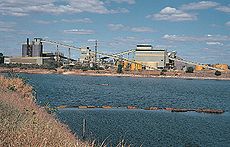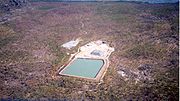
Uranium mining controversy in Kakadu National Park
Encyclopedia

Kakadu National Park
Kakadu National Park is in the Northern Territory of Australia, 171 km southeast of Darwin.Kakadu National Park is located within the Alligator Rivers Region of the Northern Territory of Australia. It covers an area of , extending nearly 200 kilometres from north to south and over 100 kilometres...
, located in the Northern Territory
Northern Territory
The Northern Territory is a federal territory of Australia, occupying much of the centre of the mainland continent, as well as the central northern regions...
of Australia
Australia
Australia , officially the Commonwealth of Australia, is a country in the Southern Hemisphere comprising the mainland of the Australian continent, the island of Tasmania, and numerous smaller islands in the Indian and Pacific Oceans. It is the world's sixth-largest country by total area...
, possesses within its boundaries a number of large uranium
Uranium
Uranium is a silvery-white metallic chemical element in the actinide series of the periodic table, with atomic number 92. It is assigned the chemical symbol U. A uranium atom has 92 protons and 92 electrons, of which 6 are valence electrons...
deposits. The uranium is legally owned by the Australian Government, and is sold internationally, having a large effect on the Australian economy. The mining has been controversial, due to the widespread publicity regarding the potential danger of nuclear power
Anti-nuclear
The anti-nuclear movement is a social movement that opposes the use of nuclear technologies. Many direct action groups, environmental groups, and professional organisations have identified themselves with the movement at the local, national, and international level...
and uranium mining
Uranium mining
Uranium mining is the process of extraction of uranium ore from the ground. The worldwide production of uranium in 2009 amounted to 50,572 tonnes, of which 27% was mined in Kazakhstan. Kazakhstan, Canada, and Australia are the top three producers and together account for 63% of world uranium...
, as well as because of objections by some indigenous
Indigenous Australians
Indigenous Australians are the original inhabitants of the Australian continent and nearby islands. The Aboriginal Indigenous Australians migrated from the Indian continent around 75,000 to 100,000 years ago....
groups. This controversy is significant because involves a number of important political issues in Australia: Native Title, the environment, and Federal-State-Territory relations.
Kakadu National Park is on the World Heritage List, both for its cultural and natural value, a rare feat because few sites are featured for both reasons.
There have been at least 150 leaks, spills and licence breaches at the Ranger Uranium Mine
Ranger Uranium Mine
The Ranger uranium mine is surrounded by Kakadu National Park, in the Northern Territory of Australia, 230 km east of Darwin. The orebody was discovered in 1969, and the mine commenced operation in 1980, reaching full production of uranium oxide in 1981...
between 1981 and 2009.
History of uranium mining in Kakadu

In the 1970s, many new deposits were discovered by aerial and ground surveys. After a series of studies and reports, the Commonwealth of Australia and the Northern Land Council
Northern Land Council
The Northern Land Council is in the Top End of the Northern Territory of Australia. It has its origins in the struggle of Australian Aboriginal people for rights to fair wages and land. This included the strike and walk off by the Gurindji people at Wave Hill, cattle station in 1966. The head...
, which represented the traditional Aboriginal land owners, reached an agreement on mining, and in 1980 the Ranger Uranium Mine was completed on land owned by the Kakadu Land Trust. Technically the site of the Ranger mine and the adjacent Jabiluka
Jabiluka
Jabiluka is a uranium deposit and mine development in the Northern Territory of Australia that was to have been built on land belonging to the Mirarr Aboriginal people...
area are not part Kakadu National Park, but are completely surrounded by it, as they were specifically excluded when the park was established from 1981.
Energy Resources of Australia
Energy Resources of Australia
Energy Resources of Australia Ltd is a public company based in Australia. It is a subsidiary of the Rio Tinto Group which owns 68.4% of the company. The chairman is David Klingner and chief executive officer is Harry Kenyon-Slaney....
(ERA) pays 4.25% of its gross sales revenue plus an annual rental of $200,000 for the use of the land and Ranger has paid over $200 million in royalties since 1980. The money is paid to the Commonwealth Government and ultimately distributed to Northern Territory-based Aboriginal groups, including the Traditional Owners, under the terms of the Commonwealth's Aboriginal Land Rights (NT) Act
Aboriginal Land Rights Act 1976
In Australian history, the Aboriginal Land Rights Act established the basis upon which Aboriginal people in the Northern Territory could claim rights to land based on traditional occupation. The Act was strongly based on the recommendations of Justice Woodward, who chaired the Aboriginal Land...
of 1976.
Following a lengthy and exhausting negotiation process, Indigenous
Indigenous Australians
Indigenous Australians are the original inhabitants of the Australian continent and nearby islands. The Aboriginal Indigenous Australians migrated from the Indian continent around 75,000 to 100,000 years ago....
leaders agreed in 1981 to terms with Pancontinental Mining to allow the construction of an underground uranium mine at Jabiluka
Jabiluka
Jabiluka is a uranium deposit and mine development in the Northern Territory of Australia that was to have been built on land belonging to the Mirarr Aboriginal people...
. Scepticism remains to this day over the fairness of this agreement. Some suggest that indigenous leaders were worn down by the negotiation process and compromised in order for it to be finished. Jabiluka was bought by Energy Resources of Australia
Energy Resources of Australia
Energy Resources of Australia Ltd is a public company based in Australia. It is a subsidiary of the Rio Tinto Group which owns 68.4% of the company. The chairman is David Klingner and chief executive officer is Harry Kenyon-Slaney....
(owners of the nearby Ranger mine) in 1991.
In 1998, UNESCO
UNESCO
The United Nations Educational, Scientific and Cultural Organization is a specialized agency of the United Nations...
's World Heritage Committee
World Heritage Committee
The World Heritage Committee establishes the sites to be listed as UNESCO World Heritage Sites. It is responsible for the implementation of the World Heritage Convention, defines the use of the World Heritage Fund and allocates financial assistance upon requests from States Parties...
announced that they proposed to list the park as "in danger" because of uranium mining, but this tag was not applied after a subsequent analysis by the World Heritage Committee when the Environment Minister, Robert Hill
Robert Hill
Robert Hill may refer to:*Robert Hill , former Australian Senator, Defence Minister and Ambassador to the United Nations*Robert Andrews Hill , U.S. federal judge*Robert C. Hill , American diplomat...
observed that many world heritage areas have mining and other extractive industries in or adjacent to them. Both the Ranger mine and the Jabiluka mining lease predate the national park and world heritage area.
In 1999, the UNESCO's World Heritage Committee held their third extraordinary session "to decide whether to immediately inscribe Kakadu National Park [Australia] on the List of World Heritage in Danger." The proposal was turned down by the large majority of the Committee who saw that the threat was not urgent enough, therefore the sovereignty of Australia must be respected. The Committee could only "expresses its deep regret" that the voluntary suspension of construction of the mine decline at Jabiluka has not taken place, and was "gravely concerned" about the serious impacts to the living cultural values of the park.
Expansion of Park
In 2010, Jeffrey LeeJeffrey Lee
Jeffrey Lee is the sole member of the Djok clan and the senior custodian of the Koongarra uranium deposit.The land owned by the clan is surrounded by Kakadu National Park. He has become famous since he doesn't want to sell the high-valued fields to the French energy giant Areva who plans to...
, an Aboriginal landowner, offered thousands of hectares of his land to the Federal Government on the condition that it be added to Kakadu National Park. The land is rich in undeveloped uranium deposits, which could be worth billions of dollars.
Potential danger and controversy regarding uranium mining

Brian Ross Martin
Brian Ross Martin AO QC was the Chief Justice of the Supreme Court of the Northern Territory from 2004 to 2010. He was sworn in as the Northern Territory's fifth Chief Justice on 27 January 2004 following the retirement of Brian Frank Martin.At the time of his appointment he was a judge of the...
disagrees, however, and has voiced that there would be no harm to the environment. The United Nations voiced its official opinion the mine would not endanger the environment or traditional sites:
The United Nations Educational, Scientific and Cultural Organisation (Unesco) ruled against placing the World Heritage-listed Kakadu National Park on its "in danger" list after accepting assurances the mine would neither harm its environment nor endanger sacred Aboriginal sites.
Both nuclear power
Nuclear power
Nuclear power is the use of sustained nuclear fission to generate heat and electricity. Nuclear power plants provide about 6% of the world's energy and 13–14% of the world's electricity, with the U.S., France, and Japan together accounting for about 50% of nuclear generated electricity...
and the extraction of raw uranium ore have always had hazardous waste issues. Concern at Kakadu is that mine tailings and contaminated water may poison Aboriginal water and food supplies, with fatal consequences for local indigenous groups. Research and monitoring conducted since 1978 by the Australian Government's Supervising Scientist
Supervising Scientist
The Supervising Scientist is a statutory office under Australian law, originally created to assist in the monitoring of what was then one of the world's largest uranium mines, the Ranger Uranium Mine...
for the Alligator Rivers Region has indicated that uranium mining at Ranger has not resulted in any harm to the environment of Kakadu National Park.
In 2004, a number of mining workers in Kakadu became ill after potable water at the mine site became contaminated with process water.
There have been more than 150 leaks, spills and licence breaches at the Ranger uranium mine since it opened in 1981. As of March 2009, the Ranger uranium mine is leaking 100,000 litres of contaminated water into the ground beneath the Kakadu National Park every day, according to a government appointed scientist. Energy Resources of Australia has been repeatedly warned about its management of the mine.
Benefits of uranium mining
The benefits to Australia of uranium mining in Kakadu are mainly economic. Australia possesses 24% of the world's uranium deposits, and the sale of this uranium has potential to be a huge boost for the Australian economy.From 2000 to 2005 nearly 50,000 metric tonnes of Uranium oxide were exported from Australia to eleven different countries. This brought over A$2.1 billion dollars to the Australian economy.
Opponents of uranium mining in the Alligator Rivers
Alligator Rivers
The Alligator Rivers is the name of a region in the Arnhem Land region of the Northern Territory of Australia, containing three rivers the East, West and South Alligator River...
region claim that these benefits have not reached local communities of traditional land owners, who remain poorly resourced, under-employed, and economically disadvantaged. In contrast, official Australian Government reports, state that there have been many benefits brought to Aboriginal communities:
Since agreement was reached with traditional owners in 1978, a total of $145.8 million in payments has been made to Aboriginal interests, of which $1.9 million was in up front payments; $3.4 million was in rental payments and $140.5 million was in royalty equivalent payments.
The proposed Jabiluka mine has already generated $5.2 million in benefits for Aboriginal people. While no production-based royalties can be paid before production commences, it is expected that over its life, the Jabiluka mine will contribute a further $230 million to Aboriginal interests.
See also
- Uranium mining in AustraliaUranium mining in AustraliaRadioactive ores were first extracted at Radium Hill in 1906, and Mount Painter in South Australia in the 1930s, to recover radium for medical use. Several hundred kilograms of uranium were also produced....
- Nuclear Non-Proliferation TreatyNuclear Non-Proliferation TreatyThe Treaty on the Non-Proliferation of Nuclear Weapons, commonly known as the Non-Proliferation Treaty or NPT, is a landmark international treaty whose objective is to prevent the spread of nuclear weapons and weapons technology, to promote cooperation in the peaceful uses of nuclear energy and to...
- Anti-nuclear movement in AustraliaAnti-nuclear movement in AustraliaNuclear testing, uranium mining and export, and nuclear energy have often been the subject of public debate in Australia, and the anti-nuclear movement in Australia has a long history...
- Uranium in the environmentUranium in the environmentUranium in the environment refers to the science of the sources, environmental behaviour, and effects of uranium on humans and other animals. Uranium is weakly radioactive and remains so because of its long physical half-life...
- List of Australian inquiries into uranium mining
Further reading
- Australia. Aboriginal and Torres Strait Islander Commission. Submission to the UNESCO World Heritage Committee on world heritage properties in Australia and Kakadu [electronic resource].[Canberra] : Aboriginal and Torres Strait Islander Commission, 2000.http://www.atsic.gov.au/issues/Indigenous_Rights/International/UNESCO/UNESCO_submission.pdf
- Grey, Anthony J. (1994) Jabiluka: the battle to mine Australia's uranium Melbourne: Text Publishing. ISBN 1863720405
- Lawrence, D. (2000). Kakadu: the making of a national park. Melbourne: University of Melbourne.

